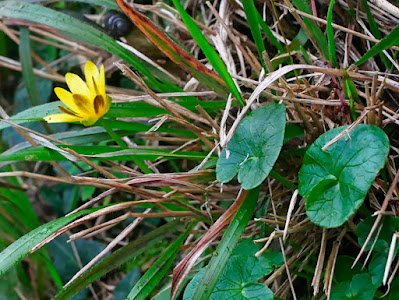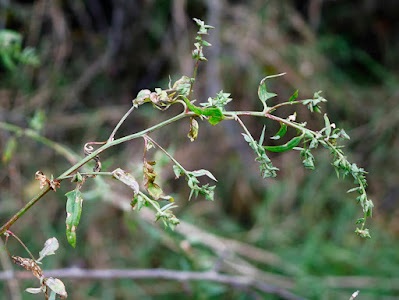It's been a wet but mild month and with the daylight hours becoming fewer, there's nowhere near as much to find as I might have done a few weeks ago. However, I am ever the optimist when I venture out and I did find some plants of interest, these follow below.
A visit to Daymer Bay found some scattered Carline Thistles. This one had gone to seed, but to be fair, they don't look much different when in flower!
Carlina vulgaris
When they are flowering, the centre amber coloured fluffy bit in the middle, has rings of 5 merrous flowers, with white or purple petals. Here's a photo I took of one in Kent a few years back so you can see for yourself what they look like in flower.
Not far from the thistles were several Evening Primroses. This one was the hybrid between Common and Large-flowered called, Intermediate Evening Primrose.
Oenothera x fallax
Nearby was one of the parent species, Common Evening Primrose. It lacks red colouring to the sepals and pods which you can see in the hybrid above and has no red blisters on the stems from which the stem hairs arise. Also in Common Evening Primrose, the stamens are about the same length as the style and with much smaller flowers than Large-flowered.
Oenothera biennis
It had poured down with rain the previous few hours, so many flowers around had closed up or looked a bit bedraggled like this Common Storksbill below.
Erodium cicutarium
Whilst on my knees looking in the short coastal turf, I noticed a shiny black beetle. I researched it and I think it is an Umbellifer Leaf Beetle though it was on Mouse-ear Hawkweed. However, Sea Carrot and Garden Parsley were close by.
Chrysolina oricalcia
A few days later I took a slow walk around Portloe on the Roseland Peninsular with this south coast location making a welcome change to the rugged north coast cliffs of Cornwall. On a roadside wall I found some Wall-rue which is always nice to find.
Asplenium ruta-muraria
On a path from the village to the coast path I came across a patch of Pink Purlane which is widely naturalised in Cornwall and can spread without human help (i.e. not planted or just surviving where dumped with soil). I've even found them along rural roadside verges in the Cornish hedge/walls.
Claytonia sibirica
The biggest surprise of this trip to Portloe wasn't a rare or unusual plant, but a common spring flowering species called Lesser Celandine. The surprise was that I found one in flower, by far the earliest flowering time for me seeing it. Previously late December was the earliest I had seen a few flowering. I guess this had something to do with the very mild and damp Autumn so far.
Ficaria verna
Birdsfoot is a small plant with tiny flowers (alas not out now) and I commonly find it in poor, thin soils. It's just at home in habitats like the Bodmin Moor; on coastal cliffs and paths; china clay waste sites and even on pasture turf where cattle have poached the soil causing bare patches in the earth.
Ornithopus perpusillus
Sea Radish was abundant along the cliff path close to the sea, but only one plant still had flowers, the rest were in seed, with their distinctive pods which are edible too.
Raphanus raphanistrum subsp. maritimus
A fallow arable field just off the coast path threw up some nice plants such as this Common Ramping Fumitory. There were at least 100 plants in this field alone.
Fumaria muralis
Also present was the largest amount of Corn Spurry I had ever seen in one field, probably thousands of plants. Of course, due to the damp, dull weather, only a few had open flowers.
Spergula arvensis
Field Woundwort was the last interesting species in this field.
Stachys arvensis
As I returned to the village, I found some very early flowering Sweet Violets, and I saw many Common Dog Violets (Viola riviniana) in flower on the same walk too.
Viola reichenbachiana
Late in the month, I took a short walk along the river Camel at Wadebridge whilst my partner was in the nearby doctor's surgery. I was very surprised to stumble upon a clump of Long-stalked Orache growing by the town slipway. This is a rare plant in Cornwall, though I had previously discovered two other populations nearby, so it wasn't a total surprise. The BSBI referee for Atriplex confirmed its identity. I didn't have a camera with me, so I picked a sprig to take home to verify it. The plant's seeds were numerous on the slipway waiting for the next spring tides to carry them off to populate new areas.
This species has (as the name suggests) long stalks to the bracteoles and it's leafy to the tip of the plant. The bracteoles are of two sizes, larger ones to 1cm long on stalks and smaller ones to 5mm in the leaf axils. The smaller bracteoles often have one of two indistinct tubercles on each side of the bracteoles too.
Atriplex longipes
My last walk of the month was along the Camel Trail upstream of Bodmin where I found the distinctive leaves of Sanicle. It will flower in the Spring next year I hope.
Sanicula europaea
My final offering in this blog was another early flowering species, Winter Heliotrope. It's a garden escaped species which has widely naturalised throughout the southern UK and is now very common. It usually flowers from mid to late December into January, but it's already started flowering, a few weeks early.
Petasites pyrenaicus
These species coming into flower early could lead one to think that the winter to come will be mild, however, I'm writing this on the last day of November with snow on the ground on the moors and very cold temperatures over the whole of the UK. So, on balance, I think that a few plants just take advantage of the conditions in autumn if they are suitable and flower early. The vast majority will flower at their usual times, thus ensuring the continuation of those species should the Autumn flowering plants not survive to seed.
Until next time, take care
Dave
Botany2021
















































